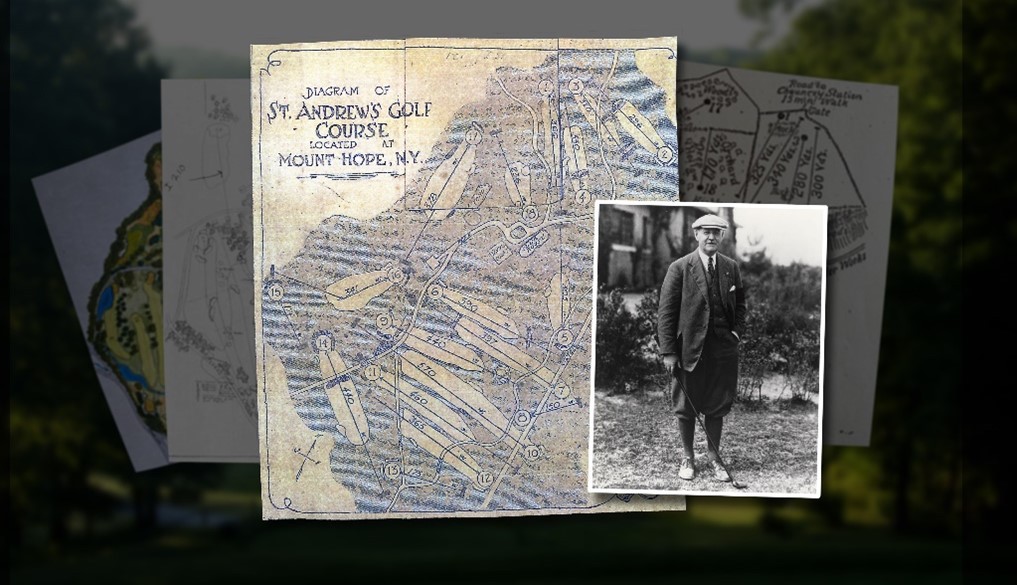HASTINGS-ON-HUDSON, N.Y. – Responsibility for the numerous design changes made to The Saint Andrew’s Golf Club’s back nine during the Club’s first two decades of play at its Hastings-on-Hudson course has long been a subject of controversy, including a debunked claim of involvement by the estate of Alister MacKenzie. This topic has been put to rest by research confirming that it was the 1914 design work of Donald Ross that resolved the layout challenges that had bedeviled the Club and brought an end to an era of continuous change.
Following extensive research, the Saint Andrew’s Historical Committee recently presented the case supporting Ross’ role in the redesign of (then) holes 10-14 in the period 1914-1917. Last month, Brad Becken, President of the Donald Ross Society, met with representatives of The Saint Andrew’s Golf Club, America’s oldest continuously operating golf club, to review the meticulously prepared report, including Board of Directors’ minutes, drawings, and other supporting documents from the early 1900’s.
Since its founding in 1888, the Club has had golf courses on four sites. The current course, at the time within the village of Mt. Hope, opened in 1897. Situated along a tributary of the Sprain River, the location offered a lush valley surrounded by craggy, wooded foothills. This terrain provided dramatic elevation changes and stunning sight lines but created layout challenges that manifested almost immediately. By 1901, four back-nine holes had been redesigned; by 1913, holes 10-14 had been changed at least seven times.
Ross’ redesigns resolved these issues and remained in play, with little change, for 65 years. In 1983, Jack Nicklaus Associates redesigned and modernized the Mt. Hope course, eliminating Ross’ par-three 11th hole and redirecting the 10th fairway onto what had been the 11th green. The Nicklaus organization rebuilt tees, greens, and bunkers, and introduced water hazards throughout the course. However, the fairway lines of Ross’s holes 12, 13 and 14 were not altered and the hand of Donald Ross continues to play a prominent role in Saint Andrew’s highly regarded contemporary course.
Becken commended the Club’s Historical Committee, saying, “You have compiled a remarkable history of the Saint Andrew’s course and, despite all of the changes over time, present it in a clear and understandable way.”
In referencing the Donald Ross Society’s official Ross club list, he declared unequivocally, that going forward, “Saint Andrew’s will be in the book.” A Saint Andrew’s hole flag will now be on display in the Tufts Archives (Pinehurst, North Carolina), signifying the course’s inclusion in the illustrious portfolio shaped by Ross.
For additional information about The Saint Andrew’s Golf Club, access the web site at www.saintandrewsgolfclub.com, follow on Instagram @saintandrewsgolfclub, or on Twitter @sagc1888.
 About The Saint Andrew’s Golf Club
About The Saint Andrew’s Golf Club
Founded in 1888, The Saint Andrew’s Golf Club is America’s oldest golf club and a founding member of the USGA. Located only 20 miles from New York City, members and their guests enjoy the game in a spectacular setting and play one of the area’s best-conditioned and exciting layouts — a challenging par-71 golf course, redesigned by Jack Nicklaus in 1983. The Club also features the Apple Tree Learning Center, a state-of-the-art teaching facility open year-round for practice and professional instruction and is ranked among the top 50 practice facilities in the country by the Golf Range Association of America. The attractive clubhouse, designed by noted architect R.H. Robertson, features historic displays honoring The Saint Andrew’s Golf Club traditions and founders. The Saint Andrew’s Golf Club has received an honorable mention from Platinum Clubs of America.
Media Contact:
Karen Moraghan
Hunter Public Relations
908/963-6013
kmoraghan@hunter-pr.com




